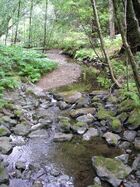Earth:Stream gradient
Stream gradient (or stream slope) is the grade (or slope) of a stream measured by the ratio of drop in elevation per unit horizontal distance,[1] usually expressed as meters per kilometer or feet per mile.
Hydrology and geology
A high gradient indicates a steep slope and rapid flow of water (i.e. more ability to erode); where as a low gradient indicates a more nearly level stream bed and sluggishly moving water, that may be able to carry only small amounts of very fine sediment. High gradient streams tend to have steep, narrow V-shaped valleys, and are referred to as young streams. Low gradient streams have wider and less rugged valleys, with a tendency for the stream to meander. Many rivers involve, to some extent, a flattening of the river gradient as approach the terminus at sea level.
Fluvial erosion
A stream that flows upon a uniformly erodible substrate will tend to have a steep gradient near its source, and a low gradient nearing zero as it reaches its base level. Of course, a uniform substrate would be rare in nature; hard layers of rock along the way may establish a temporary base level, followed by a high gradient, or even a waterfall, as softer materials are encountered below the hard layer.
Human dams, glaciation, changes in sea level, and many other factors can also change the "normal" or natural gradient pattern.
Topographic mapping
On topographic maps, stream gradient can be easily approximated if the scale of the map and the contour intervals are known. Contour lines form a V-shape on the map, pointing upstream. By counting the number of lines that cross a certain segment of a stream, multiplying this by the contour interval, and dividing that quantity by the length of the stream segment, one obtains an approximation to the stream gradient.
Because stream gradient is customarily given in feet per 1000 feet, one should then measure the amount a stream segment rises and the length of the stream segment in feet, then multiply feet per foot gradient by 1000. For example, if one measures a scale mile along the stream length, and counts three contour lines crossed on a map with ten-foot contours, the gradient is approximately 5.7 feet per 1000 feet, a fairly steep gradient.
See also
- Channel types
- Discharge (hydrology)
- Hydraulic gradient, concept used for aquifers
- Manning equation
- Relief ratio
- Rapids
- Types of waterfall
References
- ↑ Zimmer, David William; Bachmann, Roger W. (1976) (in en). A Study of the Effects of Stream Channelization and Bank Stabilization on Warm Water Sport Fish in Iowa: the effects of long-reach channelization on habitat and invertebrate drift in some Iowa streams. Iowa Cooperative Fishery Research Unit, Iowa State University. https://books.google.com/books?id=7VriHqlCehQC&q=Stream+gradient+measured+by+ratio+of+drop+in+elevation+of+a+stream+per+horizontal+distance.
 |


